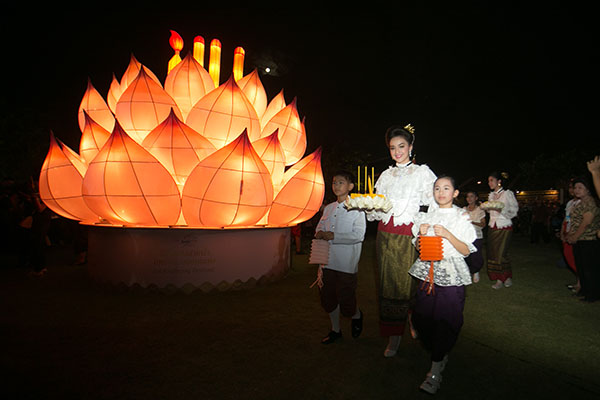There are many people who debate its origins, meanings and myths, but few would deny that Loi Krathong, with its simple beauty, symbolism and anarchic sense of fun, is the festival that most imbues Thainess.
Every year, on the full moon of the 12th lunar month, people nationwide, head out to local rivers and lakes to float banana leaf rafts, loaded with cargos of flowers, incense and candles as well as the prayers hopes and dreams of their owners. The Loi Krathong Festival 2016 falls on 14 November.
Held when the annual rains have retreated, Loi Krathong is most commonly believed to have developed from an ancient ceremony to pay respects to water spirits and thank them for their bounty. However, some speculate that it’s held in homage to an ancient goddess while others see Krathongs as offerings to apologise to rivers and streams for pollution. But whatever its origins, it is certainly a water-based festival.
This explains why it is so popular in Thailand – a nation of people who have always been happier making journeys in boats rather than boots.
The confusion arises because the celebration of the festival differs widely across the nation. In the north, particularly around Chiang Mai, it is traditional for people to release khom Loi fire lanterns into the night skies in a ceremony known as Yi Peng.
In the ancient city of Sukhothai, lanterns are floated on the ancient reservoirs, while the people of Tak province make their Krathongs from coconut shells and race them downstream. Loi Krathong in Thailand’s Northeast is celebrated differently again, with illuminated boat processions on the rivers.
So last year (2015), to give local Bangkok residents and international tourists a taste of the festival’s history and eclectic traditions, the Tourism Authority of Thailand (TAT) in collaboration with the Bangkok Metropolitan Administration as well as relevant public and private organisations arranged a celebration in Bangkok’s Nagaraphirom Park (see below pictures), with the aim of encapsulating the essence of traditional Loi Krathong festival.
There can be few better places to spend a traditional water festival than this lovely park on the Chao Phraya River. Opened in 2011, Nagaraphirom Park looks out over the stunning Temple of the Dawn, (Wat Arun).
Behind is the historic Rattanakosin Island, and the glittering spires and stupas of the Grand Palace, the Temple of the Emerald Buddha (Wat Phra Kaeo), and the Temple of the Reclining Buddha (Wat Pho) offer a backdrop that Hollywood’s most talented designers could never recreate. On the Loi Krathong night, when the full moon beams down on the people and palaces, it’s a dramatic setting to come and float banana leaf rafts.
Visitors to the celebration at Nagaraphirom Park were greeted by locals dressed in the style of courtly Thai clothing that became popular during the reign of Rama V. Atmosphere was provided by musicians playing traditional Thai instruments while the facades of traditional Thai houses formed the backdrop to the stage.
All around the park were salas where examples of traditional crafts were shown and Loi Krathong snacks prepared. The famous Luuk Chuub, which is made of mung bean, formed into the shapes of miniature fruits, was popular, as were the many coconut snacks and drinks.
But most people were here to float Krathongs so it was the “make your own Krathong” area that proved most popular. Tourists and locals sat together, decorating disks of banana stalks with leaves, candles and incense sticks; everyone competing to make the most elaborate Krathong.
When the floats were ready, people released them into the mighty Chao Phraya. Waves of candle-lit Krathongs bobbed out on the River of Kings. And it was on this famous river that the highlight of the TAT celebration was taking place.
A procession of illuminated boats, made by local colleges and private business lit up the Chao Phraya, telling stories of Thailand in glorious technicolor. The symbols of the nation were on display – there were amazing creatures from Thai mythology, such as Nagas and giants, representations of greatly-loved Thai icons such as the famous tuk-tuk, glorious temples and shadow puppets, all moving in a stately manner past Wat Arun under skies filled with fireworks and sparks, flashes and flares.
It was a colourful ending to a charming evening, and a reminder that it’s well worth travelling around Thailand to see how festivals such as Loi Krathong differ from region to region. After all, each community has different traditions and the result is a rich tapestry of Thainess that is waiting to be explored.






